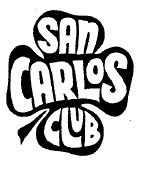The following text is a free translation taken from Pop Thing!, a site I recommend in the section "Better than me" of this blog, since they are doing a very good job from many years ago. I wrote to them few days ago, and asked for permission for the traslation of the text they have in their website on The King's Boys. They kindly gave me what I asked for the same day! Many, many thanks!! Please, have a look to Pop Thing! in order to corroborate what I am saying.
NOTE: [...] mine.* mine.
A few days ago, Josep Maria commented on the band at Loog!. He was not identified as a member of the band, but we assumed he had something to do with them and asked about it. We discover that he was the drummer of The King's Boys. Of course, we asked him to tell the story, to which he agreed immediately:
Josep Maria Bagur: "The King's Boys were formed in Barcelona in 1961 till 1969. Enric Garcia was the singer, Juan Manuel Torquemada played lead guitar, Manuel Tejada rhythm [guitar], I was the drummer, and Jordi Oliveira was the bassist . Jordi deserves special mention because, besides being the soul of the band, was admired by all other bassists of those times. Simply listen to the recordings we made to realize. Jordi had been to The Meteors and was disputed by The Mustang and by The Catinos, but [he] chose to join The King's Boys. He and I complemented each other perfectly in rhythm. That, and the voice of Enrique Garcia, did not tardásemos to record an [EP] with Belter, a company that was very important then."
*Franciska and Eliseo del Toro are brothers."The first and second EP came out in 1964. Later, in 1965, recorded the third and the last one, and that in 66 the band began to disperse. Manuel Tejada had to leave due to family problems. I also announced that I left to devote to the family business, but only when they found a replacement with sufficient guarantees. The chosen one was Rafael Carrasco, who had been the drummer of Los Sirex. By consequence of all this, Enric Garcia left. [The] others [members], flagged by the fantastic Jordi Oliveira, continued, but did not return to record a disc over and early 1970, after a tour throughout Spain, [along] with Franciska and Eliseo del Toro* (which was unsuccessful) The King's Boys were dissolved. The only thing, for quality, continued long involved with music, acting and accompanying various famous singers then, was Jordi, who died recently. "
"In our most successful period, from 1963 to 1966, [we] acted in famous landmarks such as El Pinar, the San Carlos Club, El Palacio de los Deportes (where were made some major music festivals with bands many Sunday mornings) and major nightclubs in Catalonia. During the summers, we played in different towns of the Costa Brava, which is very common in most renowned groups of those years. We tended to Blanes, San Feliu de Guixols and mainly , Lloret de Mar. In one of the festivals held in the Palacio de los Deportes (which was at Lleida St. - Barcelona), the national police suspended the act, because we caused uproar when our singer jumped into the yard seats, to a mad audience. Thanks to the timely intervention of our manager, police prevented retaliate against us. "
"The King's Boys opened the legendary San Carlos Club and act on it during the first season. Afterwards, as we had some prior commitments, we could not continue longer and were replaced by one of the great bands of the time: Los Sirex . The day was over, we played together and the two bands, to effect change, we chose a piece of Ray Charles. Undoubtedly, the public could attend an extraordinary performance of both bandss, among other things, due to the rivalry between Luis Gomis and I. Both were regarded as two of the best drummers of the moment. As you know, The Sirex dedicated a song to this hall, which incorporated to one of their discs, and entitled 'San Carlos Club', is was a customized version of 'Route 66' that made the Stones ".
Let us now listen this cover of "Just one look", by Doris Troy, and The Hollies. Enjoy!"Our band, like others of the beloved sixties, deserves all the recognition of those who now have the most sophisticated systems for both their live performances, and for the recordings. As an example of the difficulties of the time, [...] Belter studies were in the theater of La Alianza del Poble Nou. Guitars were connected directly to the recording equipment, so we could not hear what the two guitarists and bassist were playing . This also applied to my case, because the drums were settled in one of the boxes, taking advantage of the same resonance. Of course, I did not hear anything at all, and had to faithfully interpret the songs, without missing a beat, or get ahead or back, as it was the only point of reference for guitars. A mid-sixties, in Spain, there was no "cut and paste": If following the recording, it was the slightest fault, had to re-record it all again. And last but not least, the record company pushed for you that it took as little as possible, since the costs of the study were very expensives. Of course, had to finish within hours the four pieces that made an EP and could not return the next day, because that would have recording too expensive. "




No comments:
Post a Comment